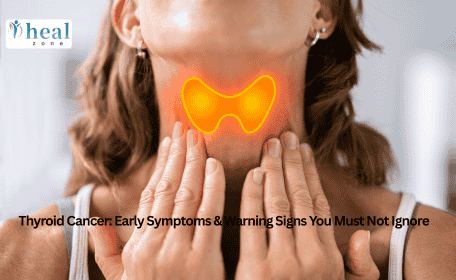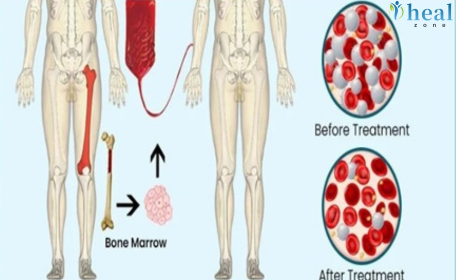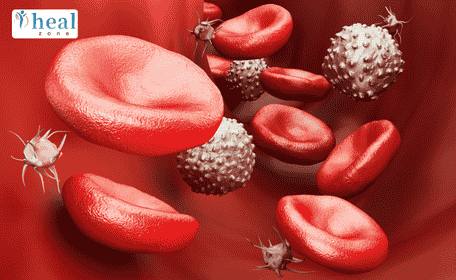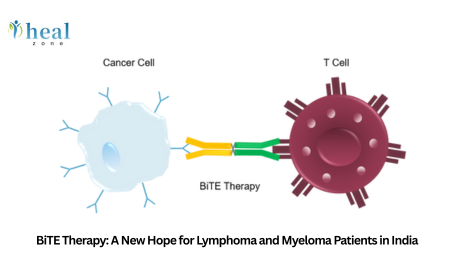Contact us
Thyroid Cancer: Early Symptoms & Warning Signs You Must Not Ignore
By Shaivana Bano
22 September 2025
- What Exactly Is Thyroid Cancer?
- Risk Factors: Who Is More Likely to Develop It?
- Why Early Detection Matters
- Key Early Warning Signs You Shouldn’t Overlook
- Subtle Symptoms People Often Ignore
- Diagnosis: How Doctors Detect Thyroid Cancer
- Treatment Options for Thyroid Cancer
- What To Do If You Notice Symptoms
- Prevention & Lifestyle Tips
- Thyroid Cancer in India: Special Considerations
- Real-Life Illustrations (Composite Examples)
- Busting Common Myths
- Final Takeaway
The thyroid gland may be tiny, but it holds immense power over how your body functions. Located in the lower front part of the neck, this butterfly-shaped organ regulates metabolism, energy levels, heart rate, growth, and even body temperature. When the thyroid is healthy, it works silently in the background. But when disease strikes — especially cancer — the consequences can be serious.
Thyroid cancer happens when cells in the gland grow uncontrollably and form a tumor. While many thyroid lumps are harmless, some can become cancerous. The biggest challenge is that symptoms may be subtle in the early stages, causing delays in diagnosis. That’s why recognizing the first warning signs is crucial.
In this comprehensive guide, we’ll explore what thyroid cancer is, who is at risk, the early symptoms to watch for, how doctors diagnose it, and the available treatment options.
What Exactly Is Thyroid Cancer?
Thyroid cancer begins when thyroid cells mutate and start multiplying without control. Instead of dying as old cells should, these abnormal cells survive and accumulate, forming a mass or nodule.
There are several types:
- Papillary thyroid cancer – The most common form, usually slow-growing and often limited to the thyroid itself.
- Follicular thyroid cancer – Less common but slightly more aggressive, with potential to spread to other organs.
- Medullary thyroid cancer – Originates from special C-cells that produce the hormone calcitonin. Sometimes linked to inherited genetic mutations.
- Anaplastic thyroid cancer – A rare but very aggressive type that spreads quickly and is harder to treat.
Each type behaves differently, but the good news is that most thyroid cancers are treatable — especially when detected early.
Risk Factors: Who Is More Likely to Develop It?
Although thyroid cancer can affect anyone, certain factors raise the risk:
- Radiation exposure – People who had radiation treatments to the head, neck, or chest (especially during childhood).
- Family history – Inherited conditions such as Multiple Endocrine Neoplasia (MEN) or medullary thyroid carcinoma.
- Gender – Women are more prone than men, though men often develop more aggressive forms.
- Age – Papillary cancer is more common in younger adults, while anaplastic cancer tends to affect older individuals.
- Iodine imbalance – Both deficiency and excess can disrupt thyroid health.
- Pre-existing thyroid conditions, such as goitre, chronic thyroiditis, or nodules, can increase the risk.
Being aware of these risk factors allows you to be extra vigilant for warning signs.
Why Early Detection Matters
Catching thyroid cancer in its initial stages has several benefits:
- Higher cure rate – Most cases diagnosed early have an excellent prognosis.
- Less aggressive treatment – Small tumours may only need partial thyroid removal instead of a total thyroidectomy.
- Lower risk of spread – Once the cancer reaches lymph nodes or distant organs, treatment becomes more complex.
- Improved quality of life – Early intervention reduces complications and long-term side effects.
Key Early Warning Signs You Shouldn’t Overlook
Thyroid cancer often starts quietly, but certain red flags should never be ignored:
1. A Lump or Nodule in the Neck
- The most common sign.
- Usually painless, firm, and slowly growing.
- It may be noticed while shaving, applying makeup, or during a routine exam.
2. Swelling in the Neck
- Visible enlargement or a feeling of fullness in the throat.
- It can make collars or scarves feel tighter.
3. Trouble Swallowing or Breathing
- A sensation of food getting stuck.
- Difficulty lying flat due to pressure on the windpipe.
4. Voice Changes or Hoarseness
- Persistent hoarseness not linked to a cold.
- Caused by tumour pressure on the nerves controlling the vocal cords.
5. Neck Pain or Discomfort
- Pain radiating to the jaw or ears.
- Usually a dull, persistent ache.
6. Persistent Cough
-
Ongoing cough without infection or allergies.
7. Enlarged Lymph Nodes
-
Swelling along the sides of the neck that feels firm.
8. Fatigue & Unexplained Weight Changes
- General tiredness.
- Unexpected weight loss without changes in diet or activity.
Important Note: Having one of these symptoms doesn’t always mean thyroid cancer. Many are caused by benign thyroid nodules or infections. However, if symptoms persist beyond a couple of weeks, it’s time to consult a doctor.
Subtle Symptoms People Often Ignore
- A tiny lump that isn’t painful.
- A raspy voice that lingers after a cold.
- Frequent throat clearing.
- Slight neck tightness when wearing high collars.
- Slight weight loss is dismissed as “dieting” or stress.
These slight hints are often overlooked but can make the difference between early detection and late diagnosis.
Diagnosis: How Doctors Detect Thyroid Cancer
When suspicious signs appear, doctors use several steps to confirm or rule out thyroid cancer:
- Physical Exam – Palpating the thyroid and checking lymph nodes.
- Blood Tests – Measuring thyroid hormones (T3, T4, TSH) and calcitonin levels.
- Ultrasound – Detects nodules, their size, and whether they look suspicious.
- Fine Needle Aspiration (Biopsy) – Cells are collected with a thin needle and examined under a microscope.
- Imaging Tests – CT, MRI, or radioactive iodine scans if spread is suspected.
- Genetic Testing – Recommended for people with a family history of medullary thyroid cancer.
Treatment Options for Thyroid Cancer
Treatment is personalised depending on cancer type, size, and spread. Common approaches include:
-
Surgery
- Lobectomy: Removing one part (lobe) of the thyroid.
- Total Thyroidectomy: Removing the whole gland.
- It may also involve removing nearby lymph nodes.
-
Radioactive Iodine Therapy
- Destroys leftover thyroid cells after surgery.
- Commonly used in papillary and follicular cancers.
-
Thyroid Hormone Therapy
- After surgery, lifelong hormone pills replace lost thyroid hormones.
- They also help prevent recurrence by suppressing TSH.
-
External Radiation or Chemotherapy
-
Rarely used, except in cases of aggressive or advanced cancers.
-
-
Targeted Therapy
- New drugs that attack specific cancer cell mutations.
- Used for resistant or advanced cases.
-
Active Surveillance
-
For very small, low-risk cancers, doctors may recommend monitoring instead of immediate surgery.
-
What To Do If You Notice Symptoms
- Stay calm – Most thyroid lumps are not cancerous.
- Consult a doctor – Start with a physician or endocrinologist.
- Note your history – Track when symptoms started and whether they’re changing.
- Follow through with tests – Don’t delay recommended scans or biopsy.
- Seek a second opinion – Especially before surgery.
- Commit to follow-up – Regular monitoring is key after treatment.
Prevention & Lifestyle Tips
While thyroid cancer cannot always be prevented, you can lower risks by:
- Eating a balanced diet with sufficient iodine.
- Avoiding unnecessary radiation exposure.
- Staying aware of family history and seeking genetic counselling if needed.
- Doing regular health check-ups and self-neck exams.
- Maintaining overall wellness through exercise, sleep, and stress management.
Thyroid Cancer in India: Special Considerations
- Awareness Gap – Many people ignore neck lumps, thinking they’re minor swelling.
- Nutritional Concerns – Certain regions still face iodine deficiency.
- Access to Care – Advanced diagnostic tools are concentrated in cities.
- Social Barriers – Fear, stigma, or financial issues delay treatment.
Raising awareness and encouraging early screening can save lives.
Real-Life Illustrations (Composite Examples)
-
Case 1 – Young Woman, Early Stage
A 34-year-old woman noticed a small painless lump while applying makeup. An ultrasound showed a suspicious nodule. Biopsy confirmed papillary thyroid cancer. She underwent a lobectomy and is now healthy with regular follow-ups. -
Case 2 – Older Man, Advanced Stage
A 62-year-old man had persistent hoarseness and difficulty swallowing. He ignored symptoms for months. By the time he sought care, the tumour had spread to lymph nodes—treatment required surgery plus radioactive iodine. Recovery was longer and more complicated.
These examples highlight the importance of acting early.
Busting Common Myths
- “All thyroid lumps are cancer.” → Most are benign.
- “If I have no symptoms, I’m safe.” → Some cancers remain silent in the early phase.
- “Surgery always means losing the whole thyroid.” → Small tumours may only require partial removal.
- “Thyroid cancer is always deadly.” → Most cases have excellent survival rates if detected early.
Final Takeaway
Thyroid cancer is one of the more treatable cancers, but only if you recognise its early signs. Look out for:
- Neck lumps or swelling
- Trouble swallowing or breathing
- Voice changes
- Persistent neck pain or cough
- Enlarged lymph nodes
- Fatigue and unexplained weight changes
If any of these persist, consult a doctor. Remember: your body whispers before it screams. Listening to those whispers can save your life. At HealZone, we encourage proactive health checks, timely consultations, and the spread of awareness. Don’t ignore what your body is trying to tell you — early detection can make all the difference.
Contact us
Written by
B.Sc. & M.Sc. in Medical Imaging Technology

Latest Blogs
Reviews
I am Fadel Abu Muhammad from Tal Afar, Iraq My father had a brain tumor. We traveled to India to Accord Specialty Hospital, New Delhi, through a resident professor, Muhammad, Dr. Vikram, who called for a laparoscopic tumor removal operation. Thank God I thank the translator, the doctor, and all the hospital staff.
Posted On
I am Muhammad Reda from Baghdad, Iraq I was suffering from weakness in my left hand. I underwent tests and it turned out that I had a brain tumor. The translator, Muqeem Muhammad, contacted us and we traveled to India. I had a neuronavigation procedure performed by Dr. Sandeep Vashya Praise be to God, the operation was completed successfully on the computer At Fortis Hospital New Delhi I thank the translator and the doctor
Posted On
All our gratitude and appreciation to the wonderful translator Mohammed Muqeem, who was truly a great support and companion during our journey for my mother’s treatment in India. He was extremely helpful, deeply understanding of all our needs, patient, and dedicated in his work, which eased a lot of the hardship and challenges we faced being away from home. His presence with us was not just about translating words but about offering real human support in every situation and every moment. May God bless him and reward him greatly for all he has done for us.
Posted On
I'm Emad Mohammed Khadir from Iraq. I was suffering from cirrhosis and liver cancer. I came to Fortis Hospital in India to see Dr. Ankur Bahil, a consultant oncologist, with the help of our translator, resident professor Mohammed Al Hindi. Thank God, we received our chemotherapy doses. The doctor and all the hospital staff were very kind and helpful. May God bless them all. Thank you.
Posted On
I am Redha Fadel from Nasiriyah, Iraq. I had a bone tumor, osteosarcoma. I traveled to India to see Dr. Ankur, a cancer specialist at Fortis Hospital, with the help of Hill Zone Medical Tourism Company, Professor Muqeem Muhammad Al Hindi. I thank you for your humanity and services.
Posted On
Peace be upon you. I am from Iraq. My brother is suffering from a tumor in his left thigh (osteosarcoma). We came to Al-Nahda for treatment. We stayed at Fortis Hospital for two months. We are now going to Iraq and will return to India to complete the treatment and the joint replacement surgery. I would like to thank the polite Indian translator, Muqeem Mohammed Al-Hindi. He was our brother before he was a translator and he helped us a lot with my brother's illness. Thank you, Muqeem. Thank you, Fortis Hospital. Thank you, Dr. Ankur.
Posted On
Peace be upon you, I'm from Iraq. My name is Majid Mazhar Kazim. My brother was suffering from tumors, so we contacted a resident professor, Muhammad Al-Hindi, and we sent him medical reports. He received us from the airport in New Delhi. I highly recommend him to Iraqi patients. He is helpful and well-mannered. He didn't hold back on us and didn't leave us alone from the first day until the last. He also took us to the airport. I thank them all.
Posted On
I am Mohammed Kazim from Iraq, from Babylon. My brother Mushtaq was suffering from meningitis. We came to India to Fortis Hospital through our resident professor, Mohammed, the director of Hill Zone Medical Services. I thank them for their kind treatment and translation. It was an enjoyable and fruitful trip. Praise be to God.
Posted On
I am from iraq tilafar, i came to India for my treatment an immune disease, i am thankful to Mr Muqeem and hospital staff, Marego Asia Hospital
Posted On
I am from Iraq. My son was suffering from Hirayama disease. I called Heal Zone, and they arranged our treatment journey. Now my son is in good health, and his finger movement has come back.
Posted On







